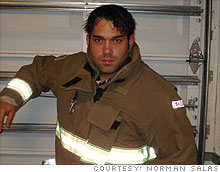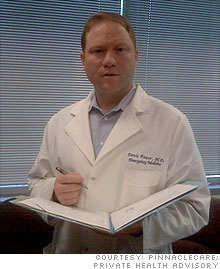911 abuse: Calling with the sniffles
Chronic abuse of 911 for non-emergency issues is wasting billions of dollars every year and overwhelming the safety net of health care. And taxpayers are left with the tab.
 |
| Lt. Norman Salas, an EMT/paramedic instructor in South Florida, said as many as 90% of the 911 calls he answers are non-emergency in nature. |
 |
| Emergency room physican Dr. Denis Pauze says abuse of 911 also reflects consumers' frustration with long waits at the doctor's office. |
NEW YORK (CNNMoney.com) -- People struggling with headaches, toothaches, and even feelings of loneliness are calling 911 -- often several times a day.
This chronic abuse is overwhelming what industry experts call the 911 "safety net" system. It's also wasting what could add up to billions of dollars every year, paid ultimately through higher taxes and medical fees.
This costly problem has gone unnoticed in the current debate on health care reform.
"Everyone's talking about the billions of dollars wasted when people misuse the emergency room in hospitals," said Jerry Johnston, outgoing president of the National Association of Emergency Medical Technicians (NAEMT). "How about the misuse of emergency services even before they reach the hospital? That's not been on anyone's radar."
The 911 system has become a sort of stop-gap primary care for many individuals, said Connie Meyer, president-elect of the National Association of Emergency Medical Technicians.
Meyer, who is an EMS captain in Johnson County, Kan., said 50% of the 35,000 911 medical calls in her county are not really emergencies. And for each 911 call, it costs between $400 to $500 to transport a person via ambulance to a hospital, she said.
"If you don't really need it, it becomes a $400 taxi to the hospital," Meyer said.
That's only the base fee for every ambulance that goes out on a call. If a person is also given treatment or medication in the ambulance or at the hospital, the cost quickly rises to $1,000, and can hit as much as $5,000.
For uninsured patients, Meyer said it's the taxpayers in her county who eventually bear the burden. They pay a $30 annual assessment for 911, and it goes toward these non-emergency treatments, rather than improvements.
Some of those who use 911 for non-life threatening reasons do so multiple times a week -- or even a day. Medics refer to them as "frequent flyers."
"For some, 911 is a necessity," Johnston said. "These people don't have [private] insurance or Medicare and 911 is their only access to health care." He said many of these people are immigrants who don't know how to navigate the system.
Others, he said, should know better. "These people have the ability to pay for care but still want to exploit the system," he said. "They know EMTs have an obligation to respond to 911 calls. People want this immediate treatment instead of having to wait in a doctor's office."
The National Fire Protection Association, which tracks 911 call volume annually, said fire departments nationwide responded to about 15.7 million total medical aid calls in 2008. Using that data, the National Academies of Emergency Dispatch, said about 20% of the calls are classified as non life-threatening and don't require a paramedic.
Norman Salas, a lieutenant and paramedic with a South Florida fire department, said more than 80% of the 911 calls he answers are routine health calls better handled by a physician or nurse.
But Salas said it's the ethical duty of a paramedic to respond to every call without judgment. "Whatever the call may be, even for a rash, we have a duty to respond," he said.
People treated by 911 responders often don't have to pay for treatment on the scene, according to emergency technicians.
Charges kick in once an individual is treated in an ambulance while they're being transported to the hospital.
"So these frequent flyers refuse transportation after we treat them, even though we always recommend that they see a doctor," Salas said.
Others are manipulating the system differently, according to Dr. Denis Pauze, an emergency room doctor at the Inova Fairfax Hospital in Falls Church, Va.
Pauze said one big misconception many people have is that coming to the hospital in an ambulance will get them faster access to a doctor.
"There are cases of people so frustrated waiting to see a doctor that they have left the ER to call 911," Pauze said. "They think they can jump the line if they're brought in by a paramedic."
In reality, Pauze said anyone with a non-emergency situation who is brought into ER will be asked to wait anyway while emergency cases are first evaluated.
Shreveport, La., fire department chief Brian Crawford, whose EMS crews responded to 26,300 medical calls last year, said departments around the country are working to find a solution to the problem.
He said public education is key to curbing abuse of 911. Also, his department and others across the country are testing a "nurse triage" system, in which a nurse will evaluate 911 calls and decide the appropriate level of emergency response.
"We've found that the cost savings offset the cost of employing a full-time nurse," he said.
"This is a delicate issue," said NAEMT's Johnston. "We don't want to come across as insensitive, but as EMS costs increase, it's leading to closures of ambulance services around the United States."
Talkback: Have you or a doctor that you know left the medical profession mid-career to start a new career outside of the health care industry? E-mail realstories@cnnmoney.com you could be part of an upcoming story. ![]()

